ML Lecture 12: Semi-supervised
Transductive learning
- unlabeled data is the testing data
Inductive learning
- unlabeled data is not the testing data
Outline
- Semi-supervised Learning for Generative Model
- Low density Separation Assumption
- Smoothness Assumption
- Better Representation
Semi-supervised Generative Model

- Initialization: 計算出每個Class的機率、平均數、變異數
- Step1(EM算法中的E): 計算每個unlabeled data屬於某個Class的機率
- Step2(EM算法中的M): 更新model
- 式1:融合labeled data和unlabeled data後,某個Class的機率
- 式2:融合labeled data和unlabeled data後,某個Class的平均數
Why

Maximum likelihood with labeled data
- 以 的條件,能夠生成 的機率
Maximum likelihood with labeled + unlabeled data
- (slide有誤)
Low-density separation
- 非黑即白
- 兩個Class之間會有一個很明顯的鴻溝
Self-training
- 現有unlabeled data與labeled data
- 使用labeled data 訓練出一個模型
- 使用這個模型去predict unlabeled data
- 選取某些預測好的unlabeled data及預測出來的pseudo label加入labeled data
- 將擴充後的labeled data再丟進模型裡訓練
- regression通常不會使用這個方法
- Hard label(0 or 1) v.s. Soft label(Prob.)
- 用hard label才有用
- 前面介紹的 semi-supervised generative model 使用的是 soft label
- 前面的generative model是使用soft label
Entropy-based Regularization
- 在unlabeled data中預測出來的class越集中越好
- 越小(接近0)越好
- Lost Function:
- 前項是原本的Loss,後面是unalbeled data的entropy,為自行決定的對unlabeled data entropy的懲罰係數
Semi-supervised SVM
- 窮舉所有unlabeled data的所有Class可能性
- 使得SVM結果error最小,並且margin最大
- 但不可能窮舉,因此一次先改一筆unlabeled data,看能不能讓 objective function(?)變大,變大就這樣改
Smoothness Assumption
假設
- 近朱者赤,近墨者黑
- x is not uniform (不平均)
- 若x1和x2之間的空間,資料點非常密集,則y1和y2會相同
實現
Cluster and then Label
- 需要有很好的方法來做clustering
- 圖片先使用 deep autoencoder抽feature,再做clustering會比較work
Graph-based Approach
- 建造graph來描述所有data point
- 建造時必須以high density path來連接,否則就算data point之間距離相近也不能做連接
- 必須自己定義graph如何建造
- 建造Graph
1. 先定義similarity function {% math %}s(x^i,x^j){% endmath %}
2. Add edge:
- KNN: 將每個data尋找最相近的前K個鄰居連起來
- e-Neighborhood: 將每個data尋找所有足夠相似(設定threshold)的其他point連起來
3. 定義ㄧ個 Edge weight 使之和 {% math %}s(x^i,x^j){% endmath %} 成正比
- **Gaussian Radial Basis Function(RBF)**較有用
- {% math %}s(x^i,x^j)=exp(-\gamma |x^i-x^j|^2){% endmath %}
- 要使用Graph-based Approach必須確保data夠多,否則在graph斷掉的情況下,label沒辦法傳遞出去
- 定義 label smoothness
- {% math %}S = \frac{1}{2}\sum_{i,j}w_{i,j}(y^i-y^j)^2 = y^TLy{% endmath %} 越小越好
- i,j為相連的兩點
- {% math %}w_{i,j}{% endmath %} 代表edge的weight,越大代表i,j兩點**離越近**
- y是(R+U)維向量,{% math %}y=[...y^i...y^j...]^T{% endmath %}
- L(**Graph Laplacian**)是(R+U)*(R+U)的matrix,{% math %}L=D-W{% endmath %}
- W是所有點之間的 connection weight matrix
- D是W矩陣的所有列總和,放在diagonal的位置
- 因此在Loss Function加入一項 smoothness: {% math %}\lambda S{% endmath %}
- {% math %}L=\sum_\limits{x^r}C(y^r,\hat y^r)+\lambda S{% endmath %}
- 若是deep network,不一定要把 smoothness 放在output的地方,可以放在任何embedding layer
Better Representation
- 去蕪存菁,化繁為簡
- **Unsupervised Learning(Lec 15?)** 會詳談
- find the latent factors(usually simpler) behind the observation